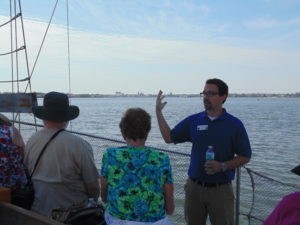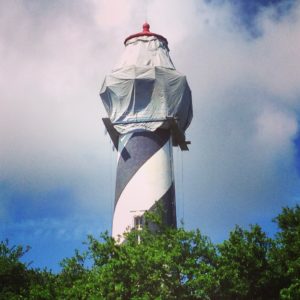From April 15-18, I had the opportunity to attend the National Council on Public History 2015 Conference in Nashville, Tenn., as a session panelist and representative of the St. Augustine Lighthouse & Museum.
When I tell people I have a degree in public history and in fact consider myself a public historian, I inevitably get in response, “What is public history?”
The definition I often give is simple; public history is the doing and sharing of history outside the traditional classroom. It is what I do as the Director of Interpretation here at the St. Augustine Lighthouse & Museum through my work designing exhibits, giving programs, and leading school tours.
While earning my M.A. in public history at the University of West Florida (Go Argonauts!), I became a member of the National Council on Public History (NCPH). Membership in NCPH allows me to develop and maintain professional relationships with colleagues across the county (and internationally) while keeping abreast of the latest developments and best practices in my field.
I was fortunate that this year, the St. Augustine Lighthouse & Museum afforded me the opportunity to attend the 2015 NCPH Conference in Nashville, Tenn. In addition to being an NCPH member, I serve on the Outstanding Public History Award Project committee, which recognizes “a project–digital, print, film, exhibit, etc.–that contributes to a broader public reflection and appreciation of the past or that serves as a model of professional public history practice.”
This year’s winner was Histories of the National Mall created by the Roy Rosenzweig Center for History and New Media at George Mason University. Visiting the site through your mobile device (smartphone, tablet) will give you an excellent on-site experience. I recommend browsing the website even if you aren’t traveling to DC soon. You will learn some interesting history of our nation’s “Front Yard.”
I attended several sessions during the conference, including one on “Pulling Back the Curtain” at museums and historic sites to show our guests how we do our work. We do a good job of this at the lighthouse through our Behind the Scenes tours, which allow tour participants to see authentic shipwreck artifacts recently recovered from the ocean floor being brought back to life in our conservation lab and learn what these processes involve.
We also ensure we have staff members on site to explain the importance of the work we do to maintain our historic structure, especially when work is ongoing like it is now with the painting of the tower. It is, after all, difficult to hide a 165 foot tall tower being painted!
Other sessions I attended included the need for History Communicators, techniques for making the Invisible Past Visible (through things like our Dark of the Moon ghost tours), and how, as an interpreter, I can combine theory and practice to enhance my exhibits and programs. My future work will certainly benefit from the insights and methods I received during the conference.
I was also fortunate to meet many graduate students and new professionals in the field of public history at the Speed Networking event held every year. I attended this worthwhile event several times myself as a student and was fortunate to give back to the public history community with whatever advice or guidance I could give to the up-and-comers. Even with as little time as I was given to spend with these bright public historians, I can say for certain that the future is bright indeed!
If you want to participate in one of our Behind the Scenes or Dark of the Moon tours, you can purchase your tickets on our website!
Paul Zielinski is Director of Interpretation for the St. Augustine Lighthouse & Museum. He received his master’s degree in Public History from the University of West Florida and joined the lighthouse family in 2011.



